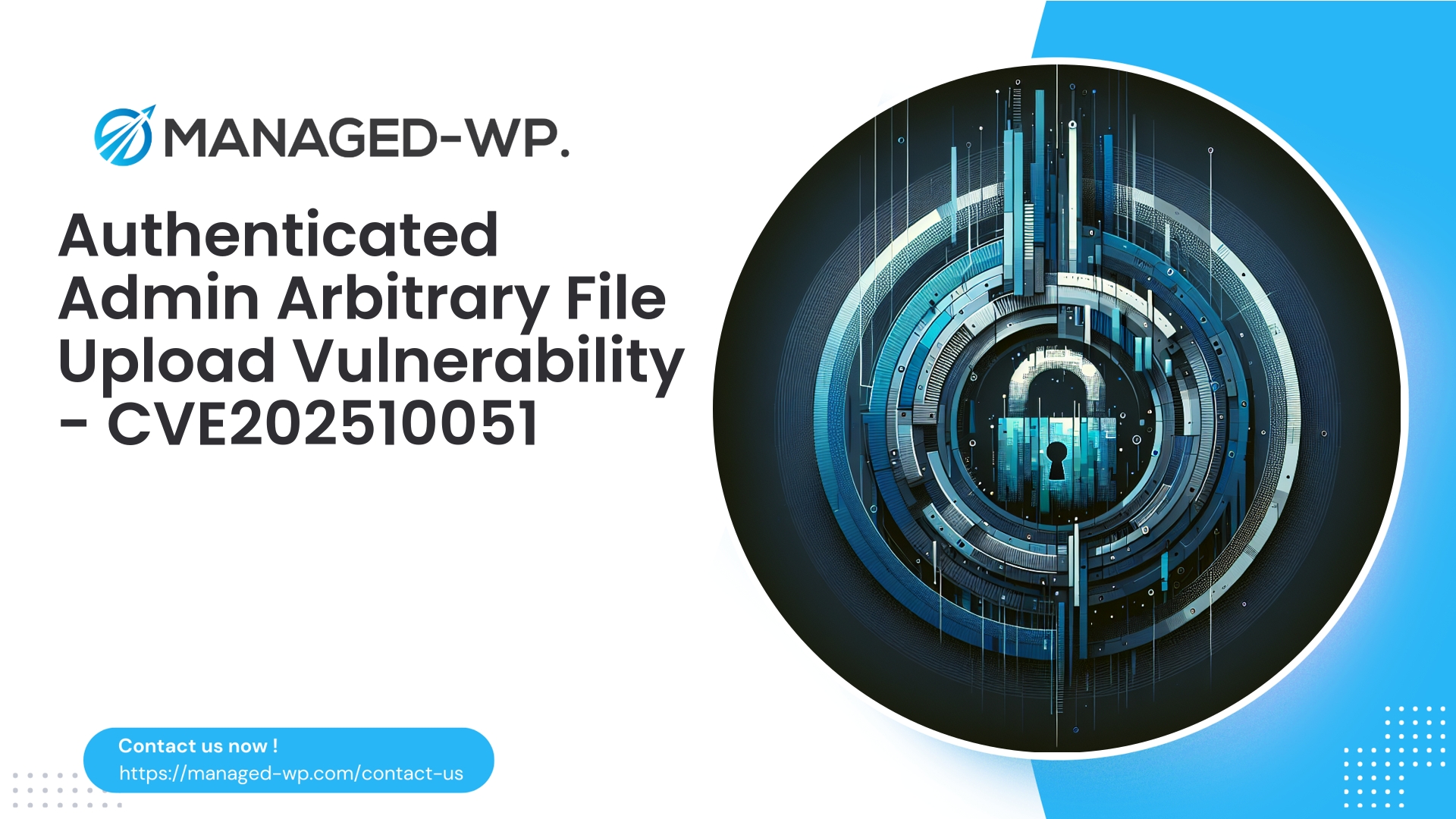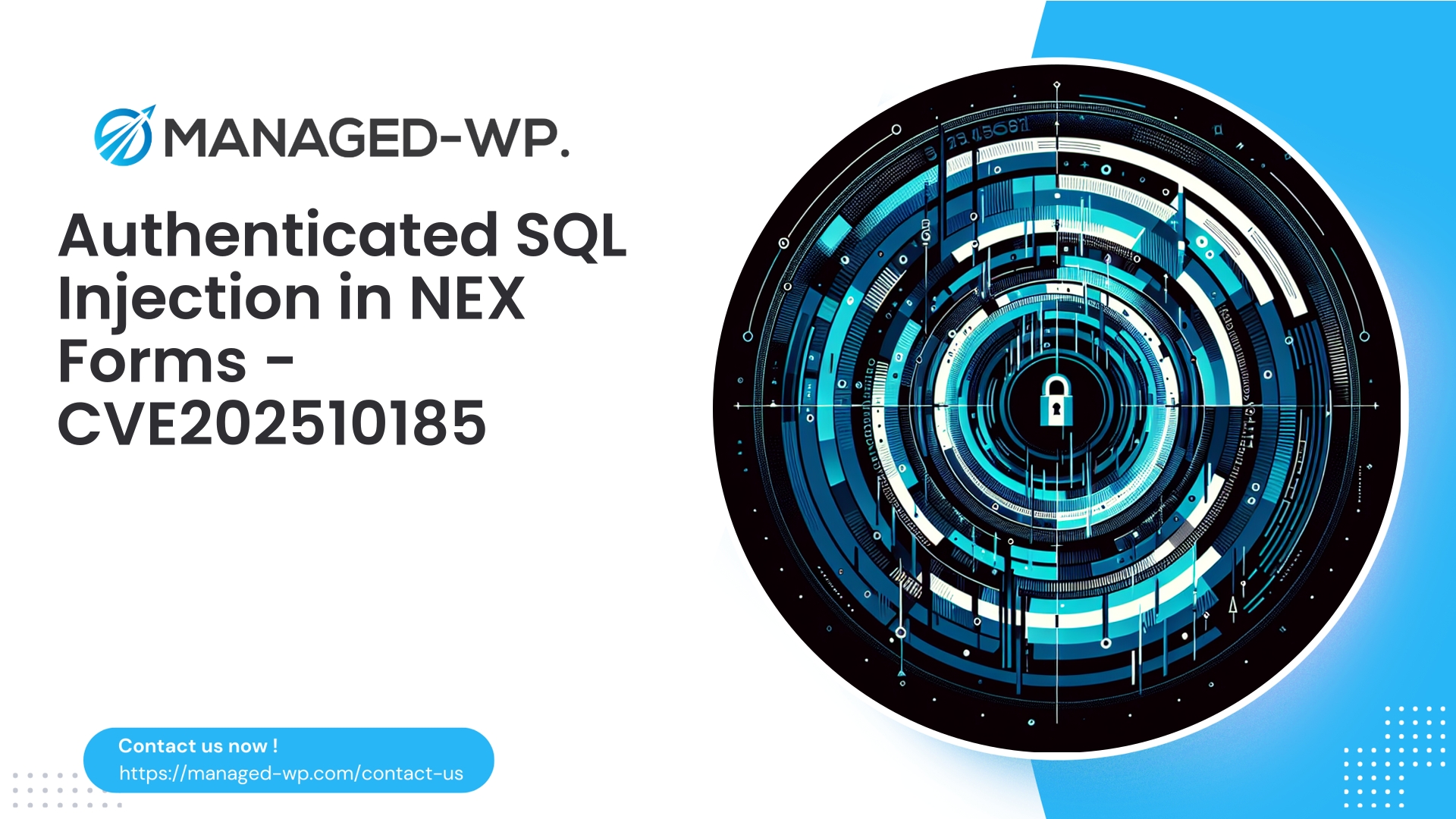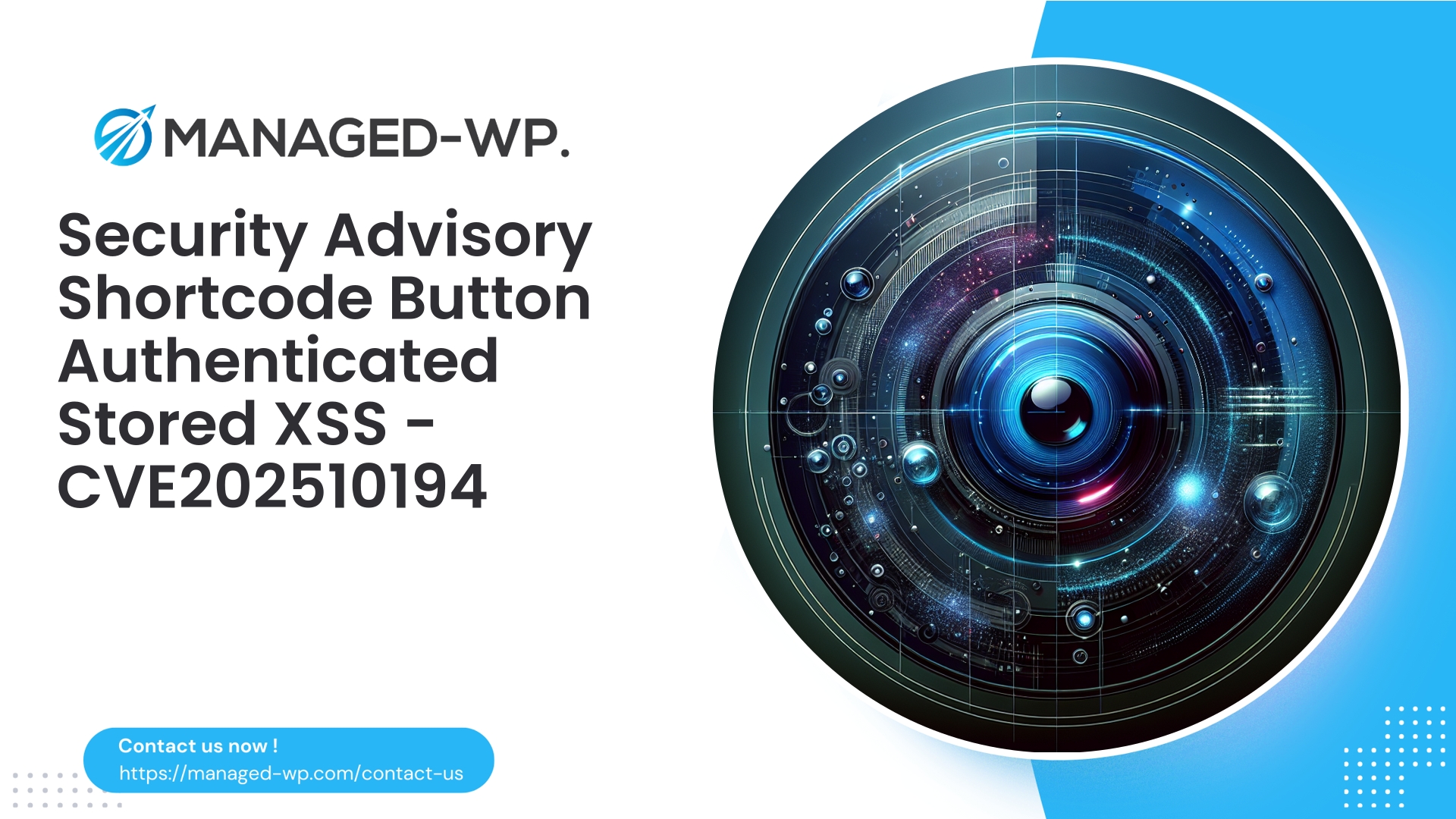| 插件名稱 | 演示導入套件 |
|---|---|
| 漏洞類型 | 已認證文件上傳漏洞 |
| CVE編號 | CVE-2025-10051 |
| 緊急 | 低的 |
| CVE 發布日期 | 2025-10-15 |
| 來源網址 | CVE-2025-10051 |
關鍵安全公告:CVE-2025-10051 — Demo Import Kit (≤ 1.1.0) 中的任意檔案上傳漏洞
託管 WordPress 安全專家分析與緩解指南
執行摘要
- Demo Import Kit WordPress 外掛程式(版本 1.1.0 及更早版本)存在一個已公開披露的已認證任意文件上傳漏洞,該漏洞已被追蹤為 [此處應填寫漏洞編號]。 CVE-2025-10051.
- 利用此漏洞需要管理員權限。擁有管理員權限的惡意攻擊者可以上傳任意檔案(包括 PHP Web Shell),這可能導致網站完全被攻陷。
- 目前尚無官方補丁可用。可立即採取的風險緩解措施包括:撤銷不必要的管理員權限、限制插件使用、透過網路應用程式防火牆(WAF)部署虛擬修補程式、加強檔案權限以及密切監控可疑活動。
- Managed-WP 提供即時的虛擬修補程式覆蓋,即使在發布官方修補程式之前也能有效阻止漏洞嘗試。
為什麼這種漏洞令人嚴重擔憂
任意檔案上傳漏洞是 WordPress 環境面臨的最嚴重安全風險之一。當攻擊者在您的伺服器上植入 PHP Web Shell 時,他們就擁有了完全控制您的網站甚至整個主機基礎架構的途徑。
雖然此漏洞需要經過驗證的管理員帳戶才能利用,但歷史資料顯示,管理員憑證經常成為撞庫攻擊、網路釣魚或社會工程攻擊的目標。一旦這些帳戶被攻破,攻擊者就可以利用此漏洞造成災難性後果。
Demo Import Kit 外掛程式對上傳的檔案及其目標目錄的驗證不正確,導致可執行檔被放置在 Web 伺服器執行它們的位置。
漏洞技術概述
- 受影響版本: Demo Import Kit 外掛程式版本 1.1.0 及更早版本。
- 漏洞: 透過面向管理員的上傳端點進行任意文件上傳,但未對文件類型和儲存位置進行適當驗證。
- 所需權限等級: 限管理員使用。
- CVE ID: CVE-2025-10051。
- 披露日期: 2025年10月15日。
- 地位: 截至本文發佈時,尚未有官方補丁可供使用。
- 發現: 由獨立安全研究人員報告。
筆記: 本公告特意排除了漏洞利用程式碼,以鼓勵負責任的處理和緩解措施。
漏洞利用原理:概要
- 管理員登入WordPress後台。
- 該外掛程式公開了一個 AJAX 或管理頁面端點,用於上傳演示導入檔案。
- 該外掛程式的上傳機制缺乏強大的驗證功能,未能正確限製檔案類型(例如,允許 PHP 檔案)和上傳路徑,這可能導致惡意程式執行。
- 上傳的檔案儲存在網路伺服器可存取和執行的目錄中。
- 攻擊者遠端存取上傳的文件,以運行任意程式碼或部署後門。
為什麼管理員帳號是高價值攻擊目標: 由於只有經過身份驗證的管理員才能觸發此漏洞,攻擊者通常會嘗試透過暴力破解、憑證重複使用或網路釣魚攻擊來取得管理員憑證。
潛在的真實世界攻擊場景
- 惡意內部威脅: 惡意管理員上傳偽裝成演示內容的 Web Shell,以維持持續的未經授權的存取權限。
- 憑證盜竊: 攻擊者利用竊取的管理員憑證部署後門。
- 社會工程學: 利用管理員權限無意中上傳惡意檔案。
- 聯合攻擊: 利用此上傳漏洞與其他漏洞結合,可以完全攻陷網站。
後果包括資料外洩、網站篡改、搜尋引擎投毒(SEO垃圾郵件)、加密貨幣挖礦、網路釣魚攻擊和進一步的網路滲透。
偵測與入侵指標 (IoC)
注意以下可能存在的剝削跡象:
- 上傳目錄中存在意外的 PHP 檔案或雙副檔名檔案(例如 image.php.jpg)。
- 最近在外掛程式或主題目錄中新增或修改了未經授權的檔案。
- 管理員日誌顯示透過 Demo Import Kit 外掛進行了異常上傳。
- Web 伺服器日誌顯示,對可疑上傳檔案的請求傳回 HTTP 200 或異常查詢參數。
- CPU 或網路使用率過高,提示可能存在加密貨幣挖礦或命令與控制活動。
- 意外的排程任務(wp-cron 作業)、建立新的管理員使用者或角色變更。
- Web 伺服器向未知 IP 位址或網域建立的出站連線。
監測最佳實踐
- 啟用詳細的伺服器端日誌記錄,以記錄上傳目錄和外掛程式目錄中的檔案變更。
- 部署檔案完整性監控 (FIM) 工具來偵測未經授權的 PHP 檔案新增。
- 定期查看 WordPress 管理員活動日誌,以發現可疑的上傳和權限提升行為。
立即緩解措施清單
如果您的網站運行的是 Demo Import Kit(≤ 1.1.0)或補丁狀態不明確,請立即實施以下操作:
- 限制管理員存取權限:
- 重置管理員密碼並強制重新驗證。
- 為所有管理員帳戶啟用強多因素身份驗證。
- 審核管理員帳戶,刪除不活躍或可疑使用者。
- 限制插件的使用:
- 如果不需要,請停用演示導入工具包。
- 如有必要,請將插件存取權限限制在受信任的管理員範圍內。
- Harden 上傳目錄:
- 透過伺服器設定(.htaccess/Nginx 規則)阻止 wp-content/uploads 中的 PHP 執行。
- 部署虛擬修補程式(WAF):
- 安裝 WAF 規則以攔截和阻止針對外掛端點的可疑上傳嘗試。
- Managed-WP 客戶可立即獲得虛擬補丁服務。
- 進行惡意軟體掃描和完整性檢查:
- 掃描未知的 PHP 檔案和已知的後門簽名。
- 移除或隔離已確認的惡意程式。
- 仔細審查日誌:
- 檢查伺服器日誌,查看是否有漏洞利用的跡象。
- 如果確認存在安全漏洞,則啟動事件回應機制。
- 備份與復原:
- 維護經過驗證的、乾淨的異地備份。
- 不要在未經驗證的情況下從入侵後建立的備份進行還原。
- 主機級安全:
- 對 WordPress 目錄強制執行最小權限檔案系統權限。
- 避免對關鍵資料夾使用 777 等寬鬆權限設定。
- 保持所有軟體更新:
- 將 WordPress 核心、外掛和主題更新到最新穩定版本。
伺服器設定範例:阻止 PHP 在上傳過程中執行
實作以下建議的伺服器指令,以防止執行上傳目錄中的 PHP 檔案。
Apache(wp-content/uploads 目錄下的 .htaccess 檔案):
# 拒絕直接存取 PHP 文件命令拒絕,允許拒絕所有# 根據伺服器版本和要求進行調整。
Nginx(在伺服器區塊內):
location ~* /wp-content/uploads/.*\.(php|php[0-9]*|phtml)$ { deny all; return 404; }
- 阻止 PHP 執行,但允許映像、CSS 和 JavaScript 正常運作。
- 對於極少數需要在上傳過程中執行 PHP 操作的情況,應採用嚴格的白名單機制。
虛擬補丁和WAF策略指南
Managed-WP 強調對易受攻擊的外掛端點進行虛擬修補,而不會中斷合法的管理工作流程。
- 阻止向管理 AJAX 或上傳端點發送帶有可執行檔案副檔名(.php、.phtml、.phar 等)的多部分 POST 請求。
- 檢查有效載荷中的 PHP 程式碼簽名,例如:
<?php屏蔽可疑內容。 - 禁止使用包含目錄遍歷序列或雙重副檔名的檔案名稱。
- 對來自異常或高風險 IP 的管理員上傳應用速率限制和地理圍欄。
- 首先在監控模式下測試 WAF 規則,以避免誤報。
推薦的事件回應工作流程
- 包含: 停用被盜帳戶,重設密碼,必要時將網站下線。
- 保存證據: 收集日誌、網頁檔案和資料庫快照的取證副本。
- 根除: 仔細清除後門和惡意檔案;清理洩漏的憑證。
- 恢復: 從完整性已驗證的乾淨備份中重建或還原。
- 恢復: 強制執行安全性加固、修補程式更新、WAF 規則和多因素身份驗證。
- 通知: 遵守所有相關的資料外洩通知法律。
- 事件後回顧: 記錄調查結果,並改善監控和安全態勢。
如果公司內部應對能力有限,則應尋求專業的事件回應服務。 Managed-WP 可以提供快速掃描和修復支援。
為什麼現在透過WAF進行虛擬修補至關重要
在沒有官方軟體更新的情況下,虛擬修補程式透過在應用層攔截惡意流量,提供即時有效的保護。這既能最大限度地降低風險,又不會造成停機,還能為永久性修復爭取時間。
優勢:
- 無需修改插件程式碼即可立即部署。
- 減少自動化和機會主義的攻擊嘗試。
- 保護多個運行相同易受攻擊插件的網站。
局限性:
- 但這並不能取代插件本身的真正修復。
- 需要持續維護和調整,以避免影響正常運作。
WordPress網站所有者的長期安全建議
- 遵循最小特權原則: 限制管理員帳戶數量,並透過細化角色劃分職責。
- 強制執行強身份驗證: 所有管理員帳號應使用唯一密碼和多重驗證。
- Vet插件和維護庫存: 只安裝來自信譽良好的來源的可信任插件,定期檢查並停用不使用的插件。
- 限制演示和導入端點: 避免在生產環境中暴露測試/演示功能;必要時限制存取權限。
- 實施持續監控: 文件完整性、稽核日誌記錄和自動漏洞掃描。
- 建立強大的備份解決方案: 使用不可更改的備份或異地備份,並定期驗證其完整性。
- 選擇安全的主機服務商: 優先選擇能夠強制執行客戶隔離、進程級保護和伺服器端安全機制的主機。
披露時間表
- 漏洞於 2025 年 10 月 15 日公開揭露。
- 分配的 CVE 識別碼:CVE-2025-10051。
- 截至披露時,尚無官方廠商提供的補丁。
- 安全研究員因發現該問題而受到表揚。
由於漏洞已公開且未發布補丁,利用漏洞的攻擊通常會迅速增加。立即採取緩解措施對於保護您的環境至關重要。
常見問題 (FAQ)
Q:如果該漏洞利用需要管理員權限,為什麼這會成為一個問題?
答:管理員帳號是網路釣魚、撞庫攻擊和其他攻擊手段的主要目標。即使只有一個管理員帳號被攻破,也會為此類漏洞等嚴重威脅打開方便之門。
Q:我可以阻止所有文件上傳以降低風險嗎?
答:雖然阻止上傳可以降低風險,但有些管理工作流程依賴合法的上傳。更平衡的方法是實施有針對性的虛擬補丁、存取限制和上傳目錄加固。
Q:卸載插件能徹底解決問題嗎?
答:移除該插件可以防止未來的攻擊嘗試,但必須單獨偵測並移除透過該漏洞上傳的任何現有後門。
Q:伺服器端的 MIME 類型檢查是否足夠?
答:這些措施雖然有用,但並非無懈可擊。縱深防禦,包括Web伺服器執行限制、WAF防護和惡意軟體掃描,至關重要。
Managed-WP 如何保護您的 WordPress 網站
在 Managed-WP,我們的安全策略專注於以最小的影響快速部署高可靠性的保護措施:
- 針對新揭露的關鍵漏洞,制定即時虛擬修補規則。
- 導入前對檔案上傳進行嚴格檢查,並對壓縮檔案進行掃描。
- 自動加固,阻止在可寫入目錄中執行 PHP 程式碼。
- 即時監控並發出異常管理員和文件活動的警報。
- 輕量級惡意軟體掃描,用於偵測常見的被利用的 webshell 和後門模式。
為了快速上手,Managed-WP 提供免費的基本保護計劃,包括託管防火牆、WAF、惡意軟體掃描和 OWASP Top 10 緩解措施——非常適合在計劃持續補救措施的同時立即降低風險。
立即使用 Managed-WP 免費版保護您的 WordPress 管理和上傳安全。
WordPress 管理員如需快速有效地抵禦 CVE-2025-10051 等威脅,我們鼓勵您註冊 Managed-WP 的免費基礎安全計劃,該計劃包含以下功能:
- 託管防火牆和全面的網路應用防火牆覆蓋。
- 無限頻寬保護,抵禦自動化攻擊。
- 按需惡意軟體掃描。
- 緩解OWASP十大風險。
立即啟動您的保護措施,並按照本指南中的步驟進行補充: https://managed-wp.com/get-started-free
對於需要自動清除惡意軟體、IP 允許/封鎖清單、詳細安全性報告和自動虛擬修補程式等進階功能的組織,請考慮我們的付費標準版和專業版計畫。
Managed-WP客戶和網站所有者的最終安全檢查清單
- 如果可以,請立即停用 Demo Import Kit 插件。
- 變更並保護管理員憑證;啟用雙重認證。
- 立即透過 Managed-WP 的 WAF 部署虛擬修補程式。
- 透過阻止 PHP 執行和掃描惡意檔案來加強上傳安全性。
- 檢查 WordPress 和伺服器日誌,尋找可疑活動。
- 定期進行乾淨備份,並在懷疑資料外洩時立即採取事件回應措施。
- 密切注意廠商更新,並在官方補丁發布後立即套用。
如果您需要專家協助實施這些防護措施,或需要在多個 WordPress 網站上快速進行虛擬修補,Managed-WP 的專業安全團隊隨時準備為您提供支援。我們的使命是在官方修復程式發布之前,確保您的網站安全、穩定且可用。



















